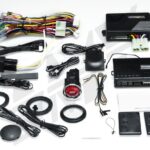Maintaining your Ford Edge 2019’s battery health is crucial for its overall performance and reliability. A key component in this system is the Battery Monitoring System (BMS), which ensures efficient charging and prevents issues related to battery drain. Understanding when and how to perform a BMS reset on your Ford Edge 2019 is essential for any owner. This article will delve into the specifics of the BMS reset for your Ford Edge 2019, drawing upon expert automotive knowledge to provide you with a comprehensive guide.
Understanding the Battery Monitoring System in your Ford Edge 2019
The Ford Edge 2019 falls under the Gen 2 category of Edge vehicles (2015-2023). These models utilize a sophisticated Electrical Management System. This system relies on algorithms within the Body Control Module (BCM) software to manage charging and electrical load. The BCM considers several factors, including:
- Battery Age: Calculated using a time-in-service counter.
- Battery State-of-Charge: Judged from up to 8 hours of historical battery voltage data.
- Battery Monitoring Sensor: A sensor mounted on the negative battery terminal clamp that provides real-time measurements.
This advanced system in your Ford Edge 2019 ensures optimal battery usage and helps to prevent premature battery failure.
When is a BMS Reset Necessary for your Ford Edge 2019?
According to Ford workshop manuals, a BMS reset on your Ford Edge 2019 (and other Gen 2 vehicles) is specifically intended for new battery installation. Performing a reset in this scenario is crucial because it:
- Establishes a new battery time-in-service counter: This ensures the system accurately tracks the age of your new battery.
- Erases battery voltage history: This clears out old data, providing a fresh baseline for the BCM algorithms to learn and adapt to the new battery’s characteristics.
By resetting the BMS after a battery replacement, you allow the Ford Edge 2019’s electrical system to function optimally with the new power source.
Addressing Faulty Battery Data in your Ford Edge 2019
Sometimes, issues like jump-starting your vehicle or using an external battery charger incorrectly can lead to inaccurate battery voltage readings. Specifically, if the negative lead is improperly connected directly to the negative battery post instead of a chassis ground during these procedures, it can disrupt the Battery Monitoring Sensor’s measurements.
In such cases, your Ford Edge 2019’s BCM might record invalid data. While a BMS reset is primarily for new battery installation, understanding how to deal with this faulty data is also important.
The 8-Hour Undisturbed Vehicle Method:
For Gen 2 vehicles like the Ford Edge 2019, the recommended approach to correct faulty data without a BMS reset procedure (outside of new battery installation) is to allow the vehicle to enter “sleep mode” undisturbed for 8 hours. This process allows the system to recalibrate using valid data.
To ensure your Ford Edge 2019 enters sleep mode quickly and effectively:
- Park the vehicle: Ensure it’s in a safe location where it can remain undisturbed.
- Close all doors, hood, and liftgate: Make sure everything is securely shut.
- Lock the vehicle: Use your key fob to lock the doors. Avoid pressing any buttons on the key fob afterwards, as this can wake the system.
During this 8-hour period, ensure there are no electrical draws exceeding 300mA. This undisturbed sleep allows the BCM to re-establish a valid historical voltage record and recalibrate the system.
Consequences of Ignoring Faulty Data:
If you don’t address the faulty data through the 8-hour method after an event like an improper jump start, your Ford Edge 2019 might experience load shedding events prematurely. Load shedding is when the vehicle’s system starts shutting down non-essential electrical functions to conserve battery power. While load shedding is a protective feature, it can be triggered unnecessarily if the BCM has inaccurate battery data.
Preventing Faulty Data in the First Place:
A simple preventative measure can save you from potential issues. When jump-starting your Ford Edge 2019 or connecting an external battery charger, always ensure the negative lead is connected to a body ground point. A common and easily accessible ground point is a shock tower sheet metal bolt head. Connecting to a body ground avoids disrupting the Battery Monitoring Sensor and prevents the creation of faulty data. By using a proper ground point, you can maintain accurate battery readings and ensure the BMS functions as intended during charging or jump-start situations.
Key Takeaways for Ford Edge 2019 BMS Reset
- BMS Reset Purpose: Primarily for new battery installation in Ford Edge 2019 and other Gen 2 vehicles.
- Faulty Data Correction: Use the 8-hour undisturbed vehicle sleep method to correct invalid battery voltage data caused by improper jump starts or charging.
- Prevention is Key: Always connect the negative lead of jump starters or external chargers to a body ground point to avoid generating faulty data.
- Optimal Performance: Proper BMS management ensures your Ford Edge 2019’s electrical system and battery perform efficiently and reliably.
By understanding and following these guidelines, you can ensure the longevity and optimal performance of your Ford Edge 2019’s battery and electrical system.
